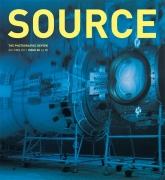Reverence and Anxiety
Thomas Struth — Whitechapel Gallery
Review by Eugenie Shinkle
Issue 68 Autumn 2011
View Contents ▸
The category of the sublime is organised around a central paradox. Sublime emotion arises only when the imagination is unable to fully grasp the size or extent of an object or concept. Classical formations of the sublime, such as Immanuel Kant’s, sought to resolve this paradox by playing the trump card of human reason: the very ability to conceptualise the ‘absolutely large’ in nature was, it was claimed, proof of the superiority of reason. Postmodern formations of the sublime are organized around a new set of limits. Now, as technology takes nature’s place as the foundation of sublime experience, humanity’s own handiwork has the capacity to exceed the power of the imagination. Born of human ingenuity but no longer fully under our control, technology is both an affirmation of reason and a dehumanizing force.
Both Classical and postmodern forms of the sublime speak to a simultaneous anxiety and a deep spiritual need for that which is greater than ourselves. The category of the sublime, in other words, has a lot to tell us about the nature and limits of the human. The same could be said of Thomas Struth’s photography. His work has always seemed to me to articulate a somewhat ambivalent relationship between humanity and its creations. Thomas Struth: Photographs 1978 – 2010 includes work from 18 separate projects spanning more than 30 years. Seen together, the various strand’s of Struth’s practice express both unease and fascination with the gulf between our capacity for producing marvels, and our capacity for fully understanding them.
This ambivalence is evident even in Struth’s early work – in the deep perspectival views down empty city streets in New York and Dusseldorf in the 1970s, and the dense, oblique vistas shot in Italy and Japan in the 1980s. Later, Struth turned his camera on the
posturban landscape, and the faceless high-rise developments springing up in Asia. Complex and tightly composed, most of his views are empty of people. More than just topographic representations of place, they diagram an urban infrastructure that is organised according to a logic which has little affinity with the lives of its inhabitants. When they are shown at all, the human actors in these scenarios are dominated by their environment, possessing the oddly disembedded air of performers on a stage. Struth’s images portray the city less as a habitat than a site for the movement of goods and the warehousing of human materiel. Tokamak Asdex Upgrade Periphery, Max Planck IPP, Garching 2009
- Thomas Struth
Tokamak Asdex Upgrade Periphery, Max Planck IPP, Garching 2009
- Thomas Struth
Shot in locations like the Max Planck Institute for Plasma Physics in Germany, and the Kennedy Space Center in Florida, Struth’s most recent work explores the correspondences between the networked environment of the contemporary city and the technological frontier of cutting-edge scientific installations. Although it is tempting to read these images as celebrations of human ingenuity, they pose technology as something more sinister – fundamentally distant and different from its creators. Bordering on the abstract, many of the images lack any indication of scale or orientation. Traces of the human, when they are present at all, come in the most banal forms: cable ties securing bundles of wires in the electrical system of a fusion reactor, a discarded glove lying on top of a particle accelerator. The organised chaos evident in these images takes yet another form in the New Pictures from Paradise, where the breathtaking complexity of high tech hardware finds an analogy in dense tangles of vegetation. Seen in the context of his other work, these ostensibly natural environments – Struth went to some lengths to locate ‘real’ rainforests – can’t help but appear manufactured: products of a post-organic world where nature has been thoroughly subsumed by technology.
The images of museum audiences appear, initially, to mitigate this rather bleak vision. The inclusion of people in Struth’s oeuvre has a certain deliberate quality to it, a kind of anthropological fascination with human emotional response. Series such as Places of Worship (1995 – 2003), Museum Photographs 1 and 2 (1989 – 2001), Audiences (2004-05), and Museo del Prado (2005) depict gallerygoers standing enthralled before works of art and tourists visiting places of religious and secular worship. But it is by no means clear whether Struth is depicting experiences of aesthetic and religious awe, or perfunctory spectatorship. The heroic examples of creativity celebrated in these photographs are framed as something distinct from – and rather more impressive than – the groups of visitors who crowd together to admire them. In some images, the sublime commingles with the banal, with culture seemingly consumed as casually and unthinkingly as any other commodity. Others appear to show genuine acts of devotion. If they express one thing clearly, it is the loss of easy distinctions between real and manufactured experience.
It is difficult to say with conviction whether Struth’s work seeks to underscore the gap between our moral architecture and our greatest artistic and technological triumphs, or whether it is an expression of faith in our ability to close it. For the Classical imagination, the frisson of sublime emotion was to be found at that point where awe threatened to tip over into terror. This capriciousness has been rather lost in contemporary uses of the term, where sublimity is often invoked simply as a synonym for admiration. Struth’s work reintroduces some of the term’s original nuance. Reflecting on the problematic boundary between reverence and anxiety, it addresses a broader set of hopes and fears that touch all of us, and asks whether the creative and spiritual achievements of our past can be counted on to carry us forward into a future that is rather more complex, and far less certain.
Other articles by Eugenie Shinkle:
Other articles mentioning Thomas Struth:
Other articles on photography from the 'Multi-Genre' category ▸






